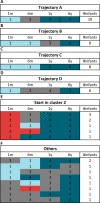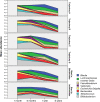Proof of principle study replicating microbial clusters in connection to birth mode and diet in the early life intestine
- PMID: 36367886
- PMCID: PMC9651555
- DOI: 10.1371/journal.pone.0277502
Proof of principle study replicating microbial clusters in connection to birth mode and diet in the early life intestine
Abstract
The human gut ecosystem starts developing at birth and is influenced by many factors during early life. In this study we make use of a Belgian cohort of 64 children, followed until the age of 6 years, to analyze different phases of microbiota development. We analyzed fecal samples taken before weaning (age 1 month), shortly after weaning (age 6 months), when milk feeding has been discontinued completely (age 1 year), and at the age of 6 years. We performed 16S rRNA gene amplicon sequencing on the collected fecal samples and analyzed the compositional data in relation to dietary metadata and birth mode. Human and formula milk feeding promotes a microbiota dominated by either Bacteroides or Bifidobacterium, respectively. Into later life stages, the microbiota composition follows distinct microbiota clusters, related to abundance dynamics of certain bacterial groups. Furthermore, it becomes apparent that a formula diet leads to early maturation of the infant gut microbiota. Despite other clinical variables within the infant cohort, they did not significantly contribute to the microbiota patterns we observed. Our data provide a proof of principle study of the importance of diet to the development of the microbiota in early life that replicates earlier findings in other cohorts.
Copyright: © 2022 Schimmel et al. This is an open access article distributed under the terms of the Creative Commons Attribution License, which permits unrestricted use, distribution, and reproduction in any medium, provided the original author and source are credited.
Conflict of interest statement
I have read the journal’s policy and the authors of this manuscript have the following competing interests: J.K. is an employee of Danone Nutricia Research. P.S., L.K., C.B. received funding from Danone Nutricia Research. This does not alter our adherence to PLOS ONE policies on sharing data and materials.
Figures












References
-
- Wopereis H, Oozeer R, Knipping K, Belzer C, Knol J. The first thousand days—intestinal microbiology of early life: establishing a symbiosis. Pediatric allergy and immunology: official publication of the European Society of Pediatric Allergy and Immunology. 2014;25(5):428–38. - PubMed
Publication types
MeSH terms
Substances
LinkOut - more resources
Full Text Sources

